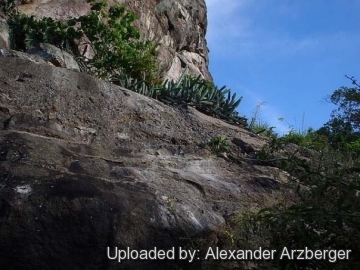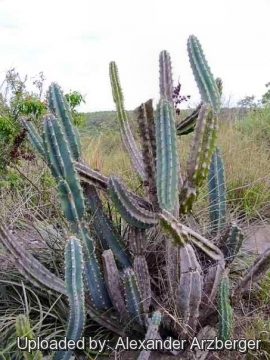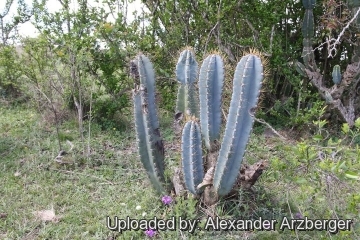
Cereus lanosus Photo by: Alexander Arzberger
Origin and Habitat: Cereus lanosusSN|7022]]SN|7022]] is endemic to Paraguay, where it occurs in Central, Cordillera, Concepción, and Paraguarí departments. This species is common and abundant where it occurs.
Altitude range: This species grows at altitudes between 250 and 300 metres above sea level.
Habitat and Ecology: It grows in rocky areas on hills. There are no known threats to this cactus.
Synonyms:
Description: Cereus lanosusSN|7022]]SN|7022]] is a shrubby, much branched, semiprostrate cactus, to 1.5 m high. It has white flowers and reproduces by seeds or cuttings.
Derivation of specific name: The Latin epithet 'lanosus', woolly, refers to the distinctive long wool of the areoles.
Stems: Long cylindrical, semi erect, blue-green, 5-7 cm in diameter.
Ribs: 5-7, to 2.5 cm high.
Areoles: Round, with long lasting, white wool.
Spines: 10-14, fine, needle-like, straight, slightly pungent, orange with reddish bases, not becoming grey, 4-10 mm long hardly distinguishable as radial and central.
Bibliography: Major references and further lectures
1) Friedrich Ritter “Kakteen in Südamerika: Ergebnisse meiner 20jährigen Feldforschung”. Volume 1, 1979
2) Pin, A. & Oakley, L. 2013. Cereus lanosus. The IUCN Red List of Threatened Species 2013: e.T152023A588296. http://dx.doi.org/10.2305/IUCN.UK.2013-1.RLTS.T152023A588296.en. Downloaded on 07 July 2016.
3) Hunt, D., Taylor, N. and Charles, G. (compilers and editors). “The New Cactus Lexicon.” dh Books, Milborne Port, UK. 2006.
4) Pin, A.B. and Simon, J. “Guía ilustrada de los Cactus del Paraguay”. SEAM/GReB, Asunción. 2004.
5) Edward Anderson “The Cactus family” Timber Press, Incorporated, 2001
6) Urs Eggli, Leonard E. Newton “Etymological Dictionary of Succulent Plant Names” Springer Science & Business Media, 29 June 2013
 In habitat. Photo by: Alexander Arzberger
In habitat. Photo by: Alexander Arzberger Cereus lanosus Photo by: Alexander Arzberger
Cereus lanosus Photo by: Alexander Arzberger Cereus lanosus Photo by: Alexander Arzberger
Cereus lanosus Photo by: Alexander ArzbergerSend a photo of this plant.The gallery now contains thousands of pictures, however it is possible to do even more. We are, of course, seeking photos of species not yet shown in the gallery but not only that, we are also looking for better pictures than those already present.
Read More... Cultivation and Propagation: Cereus lanosusSN|7022]]SN|7022]] is a poorly known species seldom seen in cultivation, it is easy to cultivate, easy to propagate, and produces numerous showy white flowers.
Growth rate: It grows quickly.
Soils: For pot culture it needs standard cactus soil. Outdoors needs well drained spots, with deep soil, but will still thrive in less than ideal conditions.
Repotting: Repotting should be done every other year, or when the plant has outgrown its pot. Use pot with good drainage.
Watering: Water regularly in summer, but do not overwater and allow to dry fully before watering again. Its roots are easily lost in pots that stay damp for any length of time. It should not be watered at all in winter. In the rest period no high atmospheric humidity!! Care must be taken with watering as they tends to become swollen and untidy in growth habit if given too much water and shade.
Fertilization: During the growing season enrich the soil using a fertilizer rich in potassium and phosphorous, but poor in nitrogen, because this chemical element doesn’t help the development of succulent plants, making them too soft and full of water.
Hardiness: Reputedly sensitive to frost and some warmth throughout the year will increase the grower's success (minimum 5° to 10°C during rest season). In presence of high atmospheric humidity make sure that your plants are not exposed to freezing temperatures, or they may die. Outdoors this plant is very adaptable, as long as you avoid excessive humidity in the winter months.
Exposition: It likes filtered sun, but is tolerant and do well with light shade during the hot Summer months, inside it needs bright light, and some direct sun.
Propagation: From cuttings in spring (let them dry till the ends callous well). Then replant them in fresh cactus soil that is ever so slightly moist, and keep them that way till they root), or by Seeds (Seeds should be sown in a well-drained soil mix. Surface sowing is the best; seeds germinate in 14-28 days at 25° C. The seedlings should not be disturbed until they are well rooted, after which they can be planted separately in small pots.













